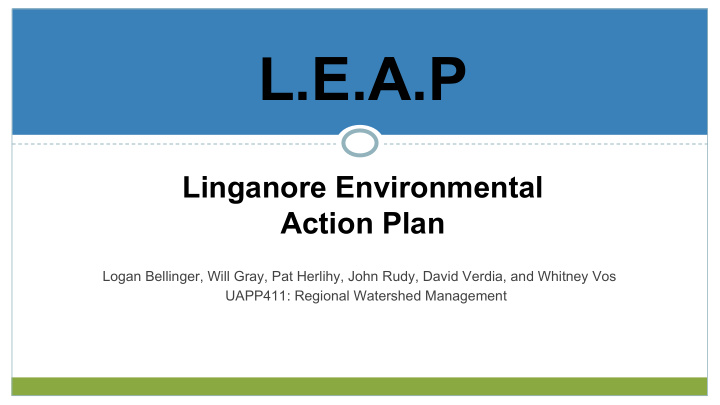



L.E.A.P Linganore Environmental Action Plan Logan Bellinger, Will Gray, Pat Herlihy, John Rudy, David Verdia, and Whitney Vos UAPP411: Regional Watershed Management
Mission Statement The ultimate goal of L. E.A.P is to ensure that the Linganore Watershed continues to provide quality municipal drinking water for this quickly growing community by restoring the rapidly shrinking capacity of the reservoir and reaching swimmable, class B, water standard by 2040.
History of Linganore ● 1960s Vacation Development ● Bankruptcy and Empty Lake/Creek ● Rapid Random Development ● Mid 2000s Frederick City Municipal ● Agriculture Impact
History ● 1972- establishment of dam across Linganore creek, creating Lake Linganore ● 1983 & 1987- Chesapeake Bay Agreement ○ VA, MD, PA concurrence of modifications to watersheds entering the Chesapeake ● 1992- Maryland Economic Growth Resource Protection and Planning act ○ location of sensitive areas in Linganore watershed by Frederick County
History ● 1998- Countywide Environmental Resource Policies ○ Comprehensive Plan- ongoing tests and studies done on the watershed to estimate what needs to be done ● 2006-2007- The Maryland Department of Agriculture (MDA) & Maryland Agriculture Cost Share Program ○ teamed up with local farmer ○ corrected issues contributing to sediment erosion and phosphorus levels
History ● 2012-2013- Town of Mount Airy ○ Put together tree planting project in upper Linganore watershed area ○ goal was to create lawns into wooded lots for better buffer and uptake ○ help funded by- Maryland Agriculture Cost Share Program
Current Linganore Table 1: Average Climatology Average Annual 66.6 F High Temperature Average Annual 45.9 F Low Temperature Average Annual 40.59 inches Rainfall Average Annual 18.7 inches Snowfall
Current Linganore Land Use: -65% Agriculture -47,000 acres -833 million gallons - population 25,000 -35% Neighborhood tracts and small business zoning
Current Linganore Water Use -Municipal Drinking Water -Recreation (boating) -Fishing
Water Impairment - Turbidity readings during - Temperature measurements spring months after ice and indicate normal readings for snow thaw, are average for cold-water streams the region, but during summer months there is a - Biodiversity was also on a dramatic increase level field with other regional watersheds, reflecting the region’s agricultural lands and recent urbanization as Frederick county grows.
Goals: Problems: Solutions: Goals, G1: Reduction in sediment P1: Runoff from farm lands S 1.1: Installation of riparian deposition by 90% and urban developments buffer zones Problems, erodes sediment into Linganore Watershed and G2: Land being development P2: Rapid urban S 2.1: Agricultural lands will be and used for agriculture are development, surrounding required to install natural buffers Solutions subject to review and historical agricultural lands, and properly manage their flow of necessary enforcement as is being poorly planned water on their lands master plan moves forward. according to its impact S 2.2: Proposed future possible. developments will require significant analysis of master planning for drainage and land use S3: Plan and build a public G3: Engage the community in P3: Current public outreach outreach project that engages the lifestyle changes regarding programs are ineffective at community their water usage engaging the public (2,500 of the community’s youth will use the park for learning)
Problem #1 Issues with sedimentation and erosion ● Steep slope of banks and lake bed drop off ● Large amounts of sediment in ag and urban runoff ● Reduced water storage capacity with this sedimentation increase
Solution #1 -Riparian Buffer Zones, Forebays, and Dredging -Regrading of the land, vegetation
Problem #2 Rapid urban development, surrounding historically agricultural lands, is being poorly planned in accordance with its possible environmental impacts.
Solution #2 - Agricultural lands will be required to install natural buffers and properly manage their flow of water on their lands - Proposed future developments will require significant analysis of master planning for drainage and land use
Problem #3 -The public in the Linganore watershed lacks the appropriate awareness and sense of urgency regarding the current and future state of its home watershed. -Public Outreach and Education Programs in the Linganore region are ineffective at changing homeowner attitudes and practices that affect water quality
Solution #3 Establish a plan for the construction of a stormwater park at Oakdale High School -Combined Enrollment 2013: 2,401 (NCES) -Over a dozen Linganore Tributaries within a mile -Several acres of impervious roof, parking lot -Runoff from I-70 and MD-144 roadways The Oakdale Stormwater Park will consist of: -a series of water quality BMP structures that treat runoff. -pathways, benches, and a small amphitheater -educational signs and markers corresponding to the plants and wildlife in the park that are native to the Linganore Watershed Park will serve as a small model for effective watershed practices
Conclusion -Historically unregulated development and agricultural industry -Contributed to Current Problems: ~Erosion and Sedimentation ~Rapid Urban Development and Agricultural Activity ~Unengaged Community Recommended Solutions: ~Combat sedimentation through infrastructure and maintenance (Dredging, Forebays) ~Management and Enforcement of development and agricultural practices (runoff, etc.) ~Outreach and Public Engagement through Oakdale High School Project
The ultimate goal of L.E.A.P is to ensure that the Linganore Watershed continues to provide quality municipal drinking water for this quickly growing community by restoring the rapidly shrinking capacity of the reservoir and reaching swimmable, class B, water standard by 2040.
Recommend
More recommend